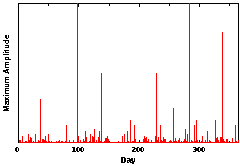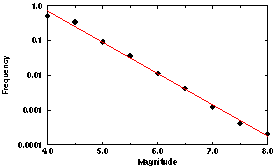Earthquake Magnitudes and the Gutenberg Richter Law
In order to study the noise of earthquakes, we must first find a way to
measure the sizes of earthquakes. Charles Richter developed the
main scale that is used today. On the Richter scale, the magnitude (M)
of an earthquake is proportional to the log of the maximum amplitude
of the earths motion. What this means is that if the earth moves
one millimeter in a magnitude 2 earthquake, it will move 10 millimeters
in a magnitude 3 earthquake, 100 millimeters in a magnitude 4 earthquake,
and 10 meters (33 feet!) in a magnitude 6 earthquake. So when you hear
about a magnitude 8 earthquake and a magnitude 4 earthquake, you now know
that the ground is moving 10,000 times more in the magnitude 8 earthquake
than in the magnitude 4 earthquake. The difference in energies is even
greater. For each factor of 10 in amplitude, the energy grows by a factor
of 32, so a magnitude 8 earthquake releases 1,000,000 times more energy
than a magnitude 4 earthquake. It is no wonder they do so much more damage!
The Gutenberg-Richter Law
 When people started measuring the magnitudes of earthquakes, they found
that there were a lot more small earthquakes than large ones. On the
right, you can see a plot of all the earthquakes of magnitude 4 or greater
in 1995. You can see that there are a few really big earthquakes, and
many many small earthquakes.
When people started measuring the magnitudes of earthquakes, they found
that there were a lot more small earthquakes than large ones. On the
right, you can see a plot of all the earthquakes of magnitude 4 or greater
in 1995. You can see that there are a few really big earthquakes, and
many many small earthquakes.
 Geologists have found that the number of earthquakes of magnitude M is proportional to
10-bM.
They call this law the Gutenberg-Richter law.
Look at the graph of all the earthquakes in 1995 on the left: the red line
gives the Gutenberg-Richter prediction with b = 1.
The value of b seems to vary from area to area, but worldwide
it seems to be around b=1.
Geologists have found that the number of earthquakes of magnitude M is proportional to
10-bM.
They call this law the Gutenberg-Richter law.
Look at the graph of all the earthquakes in 1995 on the left: the red line
gives the Gutenberg-Richter prediction with b = 1.
The value of b seems to vary from area to area, but worldwide
it seems to be around b=1.


|


